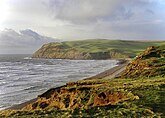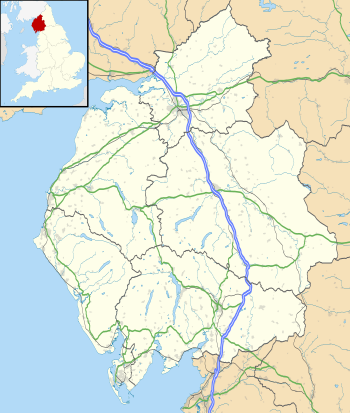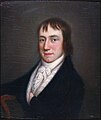|
Cumbria
Cumbria (/ˈkʌmbriə/ KUM-bree-ə) is a ceremonial county in North West England. It borders the Scottish council areas of Dumfries and Galloway and Scottish Borders to the north, Northumberland and County Durham to the east, North Yorkshire to the south-east, Lancashire to the south, and the Irish Sea to the west. Its largest settlement is the city of Carlisle. Cumbria is predominantly rural, with an area of 6,769 km2 (2,614 sq mi) and a population of 500,012; this makes it the third-largest ceremonial county in England by area but the eighth-smallest by population. Carlisle is located in the north; the towns of Workington and Whitehaven lie on the west coast, Barrow-in-Furness on the south coast, and Penrith and Kendal in the east of the county. For local government purposes the county comprises two unitary authority areas, Westmorland and Furness and Cumberland.[5] Cumbria was created in 1974 from the historic counties of Cumberland and Westmorland, the Furness area of Lancashire, and a small part of Yorkshire. The interior of Cumbria contains several upland areas. Together they fringe the Vale of Eden, the wide valley of the River Eden, which runs south-east to north-west across the county and broadens into the Solway Plain near Carlisle.[6][7] To the north-east are part of the Border Moors, and to the east part of the North Pennines; the latter have been designated a national landscape. South of the vale are the Orton Fells, Howgill Fells, and part of the Yorkshire Dales, which are all within the Yorkshire Dales national park.[8] The south-west contains the Lake District, a large upland area which has been designated a national park and UNESCO World Heritage Site. It includes Scafell Pike, England's highest mountain,[9] and Windermere, its longest and largest lake. The county has long coast to the west which is bordered by a plain for most of its length. The north-west coast is part of the Solway Firth, a national landscape, and the south coast includes the Cartmel and Furness peninsulas. East of the peninsulas, the county contains part of Arnside and Silverdale, another national landscape The county contains several Neolithic monuments, such as Mayburgh Henge. The region was on the border of Roman Britain, and Hadrian's Wall runs through the north of the county. In the Early Middle Ages parts of the region successively belonged to Rheged, Northumbria, and Strathclyde, and there was also a Viking presence. It became the border between England and Scotland, and was unsettled until the Union of the Crowns in 1603. During the Industrial Revolution mining took place on the Cumberland coalfield and Barrow-in-Furness became a shipbuilding centre, but the county was not heavily industrialised and the Lake District became valued for its sublime and picturesque qualities, notably by the Lake Poets. NameThe place names Cumbria and Cumberland both mean "land of the Cumbrians" and are names derived from the term that had been used by the inhabitants of the area to describe themselves. In the period c. 400 – c. 1100, it is likely that any group of people living in Britain who identified as 'Britons' called themselves by a name similar to 'Cum-ri' which means "fellow countrymen" (and has also survived in the Welsh name for Wales which is Cymru).[10] The first datable record of the place name as Cumberland is from an entry in the Anglo Saxon Chronicle for the year AD 945.[11] This record refers to a kingdom known to the Anglo Saxons as Cumberland (often also known as Strathclyde) which in the 10th century may have stretched from Loch Lomond to Leeds.[12] The first king to be unequivocally described as king of the Cumbrians is Owain ap Dyfnwal, who ruled from c. 915 – c. 937.[13] History Cumbria was created in April 1974 through an amalgamation of the administrative counties of Cumberland and Westmorland, to which parts of Lancashire (the area known as Lancashire North of the Sands) and of the West Riding of Yorkshire were added.[14] During the Neolithic period the area contained an important centre of stone axe production (the so-called Langdale axe factory), products of which have been found across Great Britain.[15] During this period, stone circles and henges were built across the county, and today, Cumbria has one of the largest number of preserved field monuments in England'.[16] While not part of the region conquered in the Romans' initial conquest of Britain in AD 43, most of modern-day Cumbria was later conquered in response to a revolt deposing the Roman-aligned ruler of the Brigantes in AD 69.[17] The Romans built a number of fortifications in the area during their occupation, the most famous being UNESCO World Heritage Site Hadrian's Wall which passes through northern Cumbria.[18] At the end of the period of British history known as Roman Britain (c. AD 410) the inhabitants of Cumbria were Cumbric-speaking native Celtic Britons who were probably descendants of the Brigantes and Carvetii (sometimes considered to be a sub-tribe of the Brigantes) that the Roman Empire had conquered in about AD 85.[citation needed] Based on inscriptional evidence from the area, the Roman civitas of the Carvetii seems to have covered portions of Cumbria. The names Cumbria, Cymru (the native Welsh name for Wales), Cambria, and Cumberland are derived from the name these people gave themselves, *kombroges in Common Brittonic, which originally meant "compatriots".[19][20] Although Cumbria was previously believed to have formed the core of the Early Middle Ages Brittonic kingdom of Rheged, more recent discoveries near Galloway appear to contradict this.[21] For the rest of the first millennium, Cumbria was contested by several entities who warred over the area, including the Brythonic Celtic Kingdom of Strathclyde and the Anglian kingdom of Northumbria. Most of modern-day Cumbria was a principality in the Kingdom of Scotland at the time of the Norman conquest of England in 1066 and thus was excluded from the Domesday Book survey of 1086. In 1092 the region was invaded by William II and incorporated into England.[22] In 1133 the diocese of Carlisle was founded, cementing Cumbria's position within the English church.[23] Cumbria left Scottish hands for the last time in 1157. Nevertheless, the region was dominated by the many Anglo-Scottish Wars of the latter Middle Ages and early modern period and the associated Border Reivers who exploited the dynamic political situation of the region.[24] There were at least three sieges of Carlisle fought between England and Scotland, and two further sieges during the Jacobite risings. After the Jacobite Risings of the 18th century, Cumbria became a more stable place and, as in the rest of Northern England, the Industrial Revolution caused a large growth in urban populations. In particular, the west coast towns of Workington, Millom and Barrow-in-Furness saw large iron and steel mills develop, with Barrow also developing a significant shipbuilding industry.[25] Kendal, Keswick and Carlisle all became mill towns, with textiles, pencils and biscuits among the products manufactured in the region. The early 19th century saw the county gain fame when the Lake Poets and other artists of the Romantic movement, such as William Wordsworth and Samuel Taylor Coleridge, lived among, and were inspired by, the lakes and mountains of the region. Later, the children's writer Beatrix Potter also wrote in the region and became a major landowner, granting much of her property to the National Trust on her death.[26] In turn, the large amount of land owned by the National Trust assisted in the formation in 1951 of the Lake District National Park,[citation needed] which remains the largest National Park in England and has come to dominate the identity and economy of the county. 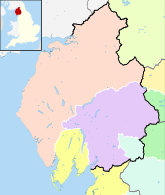 Boundary of Cumbria Historic Cumberland Historic Westmorland Historic Lancashire The Windscale fire of 10 October 1957 was the worst nuclear accident in Great Britain's history.[27] Cumbria was created in 1974 from the traditional counties of Cumberland and Westmorland, the Cumberland County Borough of Carlisle, along with the North Lonsdale or Furness part of Lancashire, usually referred to as "Lancashire North of the Sands", (including the county borough of Barrow-in-Furness) and, from the West Riding of Yorkshire, the Sedbergh Rural District.[14] Between 1974 and 2023 it was governed by Cumbria County Council but in 2023 the county council was abolished and replaced by two new unitary authorities Cumberland Council and Westmorland and Furness Council, hence Cumbria only now exists as a ceremonial county. On 2 June 2010, taxi driver Derrick Bird killed 12 people and injured 11 others in a shooting spree that spanned over 24 kilometres (15 mi) along the Cumbrian coastline.[28] Local newspapers The Westmorland Gazette and Cumberland and Westmorland Herald continue to use the name of their historic counties. Other publications, such as local government promotional material, describe the area as "Cumbria", as does the Lake District National Park Authority. Geography Cumbria is the most northwesterly ceremonial county of England and is mostly mountainous, with large upland areas to the south-west and east. The south-west contains the Lake District, a national park and UNESCO world heritage site which includes Scafell Pike, England's highest mountain at 978 metres (3,209 ft),[9] and Windermere, its longest and largest lake. The Border Moors and North Pennines lie along the county's eastern border. The south-east contains the Orton Fells, Howgill Fells and part of the Yorkshire Dales, which are all within the Yorkshire Dales national park.[8] The Vale of Eden, the valley of the River Eden, runs south-east to north-west between these upland areas, and broadens into the Solway Plain near Carlisle.[6][7] The county has long coast to the west, which is bordered by a plain for most of its length. In the north-west it borders the Solway Firth, a national landscape, and to the south are the Cartmel and Furness peninsulas. East of the peninsulas, the county contains part of Arnside and Silverdale, also a national landscape. The Lancaster Canal runs from Preston into southern Cumbria and is partly in use. The Ulverston Canal which once reached to Morecambe Bay is maintained although it was closed in 1945. Boundaries and divisionsThe northernmost and southernmost points in Cumbria are just west of Deadwater, Northumberland and South Walney respectively. Kirkby Stephen (close to Tan Hill, North Yorkshire) and St Bees Head are the most easterly and westerly points of the county. The boundaries are along the Irish Sea to Morecambe Bay in the west, and along the Pennines to the east. Cumbria's northern boundary stretches from the Solway Firth from the Solway Plain eastward along the border with Scotland. Cumbria is bordered by Northumberland, County Durham, North Yorkshire, Lancashire in England, and Dumfries and Roxburgh, Ettrick and Lauderdale in Scotland.  Economy Many large companies and organisations are based in Cumbria. The county council itself employs around 17,000 individuals, while the largest private employer in Cumbria, BAE Systems in Barrow employs around 12,000 with further job growth associated with new contracts expected, the Sellafield nuclear processing site, has a workforce of 10,000.[30] Tourism  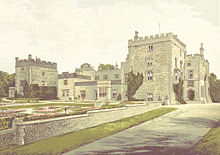 The largest and most widespread industry is tourism, with the county attracting over 47 million visitors annually.[31] The Lake District National Park alone receives some 15.8 million visitors every year.[32] Despite this, fewer than 50,000 people reside permanently within the Lake District: mostly in Ambleside, Bowness-on-Windermere, Coniston, Keswick, Gosforth, Grasmere and Windermere.[32] Over 36,000 Cumbrians are employed in the tourism industry which adds £1.1 billion a year to the county's economy. The Lake District and county as a whole attract visitors from across the UK,[32] Europe, North America and the Far East (particularly Japan).[32] The tables below show the twenty most-visited attractions in Cumbria in 2009. (Not all visitor attractions provided data to Cumbria Tourism who collated the list. Notable examples are Furness Abbey, the Lakes Aquarium and South Lakes Safari Zoo, the last of which would almost certainly rank within the top five).[33]
Economic output
GovernanceLocalCumbria is governed by two unitary authorities, Cumberland Council and Westmorland and Furness Council. The Cumberland unitary authority area covers the north and west of Cumbria, and Westmorland and Furness the south and east; they are named after the historic counties of Cumberland and Westmorland, but have different boundaries.[36] Cumberland has had a Labour majority administration since the 2022 Cumberland Council election, and Westmorland and Furness has had a Liberal Democrat majority administration since the 2022 Westmorland and Furness Council election.[37][38] Cumberland Council and Westmorland and Furness Council collaborate through a Joint Executive Committee and the Enterprising Cumbria Economic Growth Body. In September 2024, the two councils submitted an expression of interest to form a combined authority.[39] Between 1974 and 2023 Cumbria was administered by Cumbria County Council and six district councils: Allerdale, Barrow-in-Furness, Carlisle, Copeland, Eden, and South Lakeland. These were abolished on 1 April 2023, when the two unitary authorities were established.[40] The Duchy of Lancaster, the private estate of the sovereign, exercises some rights of the Crown in the County Palatine of Lancaster, which includes the Furness area of Cumbria.[41] NationalUntil the 2024 general election, there were six parliamentary constituencies in Cumbria: Barrow and Furness, Carlisle, Copeland, Penrith and the Border, Westmorland and Lonsdale, and Workington. Five were won by the Conservative Party in the 2019 United Kingdom general election, with Westmorland and Lonsdale won by the Liberal Democrats. The 2023 Periodic Review of Westminster constituencies abolished Copeland, Workington, and Penrith and the Border, replacing them with the new constituencies of Penrith and Solway and Whitehaven and Workington. The three remaining constituencies underwent significant boundary changes, including some electoral wards being transferred from Westmorland and Lonsdale to Morecambe and Lunesdale, making the latter a cross-county constituency (it had previously been exclusively in Lancashire).
PoliticsConservatives and the Liberal Democrats are strongest in rural areas, and Labour is strongest in the industrial towns.[42] Education Although Cumbria has a comprehensive system almost fully, there is one state grammar school in Penrith. There are 42 state secondary schools and 10 independent schools. The more rural secondary schools tend to have sixth forms (although in Barrow-in-Furness district, no schools have sixth forms due to the only sixth form college in Cumbria being located in the town) and this is the same for three schools in Allerdale and South Lakeland, and one in the other districts. Chetwynde is also the only school in Barrow to educate children from nursery all the way to year 11. Colleges of further education in Cumbria include:
The University of Cumbria is one of the UK's newest universities, having been established in 2007. It is at present the only university in Cumbria and has campuses across the county, together with Lancaster and London. TransportRoad The M6 is the only motorway that runs through Cumbria. Kendal and Penrith are amongst its primary destinations. Further north it becomes the A74(M) at the border with Scotland north of Carlisle. Major A roads within Cumbria include: Several bus companies run services in Cumbria serving the main towns and villages in the county, with some services running to neighbouring areas such as Lancaster. Stagecoach Cumbria & North Lancashire is the largest; it has depots in Barrow-in-Furness, Carlisle, Kendal and Workington. Stagecoach's flagship X6 route connects Barrow-in-Furness and Kendal in south Cumbria. AirThere are only two airports in the county: Carlisle Lake District and Barrow/Walney Island. Both airports formerly served scheduled passenger flights and both are proposing expansions and renovations to handle domestic and European flights in the near future. The nearest international airports to south Cumbria are Blackpool, Manchester, Liverpool John Lennon and Teesside. North Cumbria is closer to Newcastle, Glasgow Prestwick and Glasgow International. PortsBarrow-in-Furness is one of the country's largest shipbuilding centres, but the Port of Barrow is only minor, operated by Associated British Ports alongside the Port of Silloth in Allerdale. There are no ferry links from any port or harbour along the Cumbria coast. RailThe busiest railway stations in Cumbria are Carlisle, Barrow-in-Furness, Penrith and Oxenholme Lake District. The 399 miles (642 km) West Coast Main Line runs through the Cumbria countryside, adjacent to the M6 motorway. The Cumbrian Coast Line connects Barrow-in-Furness to Carlisle and is a vital link in the west of the county. Other railways in Cumbria are the Windermere Branch Line, most of the Furness Line and much of the Settle-Carlisle Railway. DemographyThe largest settlements in Cumbria PopulationCumbria's largest settlement and only city is Carlisle, in the north of the county. The largest town, Barrow-in-Furness, in the south, is slightly smaller. The county's population is largely rural: it has the second-lowest population density among English counties, and only five towns with over 20,000 people. Cumbria is one of the country's most ethnically homogeneous counties, with 95% categorised as White British (around 471,000 of the 500,000).[43] The larger towns have ethnic makeups closer to the national average. The 2001 census indicated Christianity was the religion with the most adherents in the county.  2010 ONS estimates placed the number of foreign-born (non-United Kingdom) people living in Cumbria at around 14,000 and foreign nationals at 6,000.[44] Population trends indicate a gradual decline in younger demographics, with an increasing proportion of elderly residents.[45] The 2001 UK Census showed the following most common countries of birth for residents of Cumbria that year:
Settlements
SportRunningFell running is a popular sport in Cumbria, with an active calendar of competitions taking place throughout the year. Cumbria is also home to several of the most active orienteering clubs in the UK as well as the Lakes 5 Days competition that takes place every four years. Football codesWorkington is home to the ball game known as Uppies and Downies,[49] a traditional version of football, with its origins in medieval football or an even earlier form.[50] Players from outside Workington also take part, especially fellow West Cumbrians from Whitehaven and Maryport.[51] Cumbria formerly had minor American football clubs, the Furness Phantoms (the club is now defunct, its last name was Morecambe Bay Storm) and the Carlisle Kestrels.[52] Association Barrow and Carlisle United are the only professional football teams in Cumbria. Carlisle United attract support from across Cumbria and beyond, with many Cumbrian "ex-pats" travelling to see their games, both home and away.[citation needed] Workington—who are always known locally as "the reds"—are a well-supported non-league team,[citation needed] having been relegated from the Football League in the 1970s. Workington made a rapid rise up the non league ladder and in 2007/08 competed with Barrow in the Conference North. Barrow were then promoted to the Conference Premier in 2007/08. In 2020, Barrow were promoted to the Football League as a result of winning the National League. Rugby codesRugby union is popular in the county's north and east with teams such as Furness RUFC & Hawcoat Park RUFC (South Cumbria), Workington RUFC (Workington Zebras), Whitehaven RUFC, Carlisle RUFC, Creighton RUFC, Aspatria RUFC, Wigton RUFC, Kendal RUFC, Kirkby Lonsdale RUFC, Keswick RUFC, Cockermouth RUFC, Upper Eden RUFC and Penrith RUFC.  Rugby league is a very popular sport in south and West Cumbria. Barrow, Whitehaven and Workington play in the Rugby League Championships. Amateur teams; Wath Brow Hornets, Askam, Egremont Rangers, Kells, Barrow Island, Hensingham and Millom play in the National Conference. Bat-and-ballCumbria County Cricket Club is one of the cricket clubs that constitute the National Counties in the English domestic cricket structure. The club, based in Carlisle, competes in the National Counties Cricket Championship and the NCCA Knockout Trophy. The club also play some home matches in Workington, as well as other locations. Cumbrian club cricket teams play in the North Lancashire and Cumbria League. Cumbria is home to the Cartmel Valley Lions, an amateur baseball team based in Cartmel. WrestlingCumberland and Westmorland wrestling is an ancient and well-practised tradition in the county with a strong resemblance to Scottish Backhold. In the 21st century Cumberland and Westmorland wrestling along with other aspects of Lakeland culture are practised at the Grasmere Sports and Show, an annual meeting held every year since 1852 on the August Bank Holiday. The origin of this form of wrestling is a matter of debate, with some describing it as having evolved from Norse wrestling brought over by Viking invaders,[53] while other historians associate it with the Cornish and Gouren styles[54] indicating that it may have developed out of a longer-standing Celtic tradition.[55] RacingCumbria Kart Racing Club is based at the Lakeland Circuit, Rowrah, between Cockermouth and Egremont Lakeland Circuit. The track is currently a venue for rounds of both major UK national karting championships About Cumbria Kart Racing Club. Formula One world champions Lewis Hamilton and Jenson Button both raced karts at Rowrah many times in the formative stages of their motor sport careers,[56] while other F1 drivers, past and present, to have competed there include Johnny Herbert, Anthony Davidson, Allan McNish, Ralph Firman, Paul di Resta and David Coulthard, who hailed from just over the nearby Anglo-Scottish border and regarded Rowrah as his home circuit, becoming Cumbria Kart Racing Club Champion in 1985 in succession to McNish (di Resta also taking the CKRC title subsequently).[57] Workington Comets were a Workington-based professional speedway team,[58] which competed in the British Speedway Championship.[59] FoodCumbria is the UK county with the highest number of Michelin-starred restaurants, with seven in this classification in the Great Britain and Ireland Michelin Guide of 2021. Traditional Cumbrian cuisine has been influenced by the spices and molasses that were imported into Whitehaven in the 18th century. The Cumberland sausage (which has a protected geographical status) is a well-recognised result of this. Other regional specialities include Herdwick mutton and the salt-marsh raised lamb of the Cartmel Peninsula.[60] Dialect influencesCeltic
Anglo-Saxon/Viking
Scandinavian/Norse/Dane
Normans
Cumbric
MediaTwo evening newspapers are published daily in Cumbria. The News and Star focuses largely on Carlisle and the surrounding areas of north and west Cumbria, and the North-West Evening Mail is based in Barrow-in-Furness and covers news from across Furness and the South Lakes. The Cumberland and Westmorland Herald and The Westmorland Gazette are weekly newspapers based in Penrith and Kendal respectively. The Egremont 2Day newspaper, formerly Egremont Today when affiliated with the Labour Party, was a prominent monthly publication – founded by Peter Watson (and edited by him until his death in 2014) in 1990 until July 2018. In February 2020 The Herdwick News, run by the last editor of The Egremont 2Day, was launched and is an independent online news publication covering the county of Cumbria and the North West. Due to the size of Cumbria the county spans two television zones: BBC North East and Cumbria and ITV Border in the north and centre, and BBC North West and ITV Granada in the south. Heart North West, Greatest Hits Radio Cumbria & South West Scotland and Smooth Lake District are the most popular local radio stations throughout the county, with BBC Radio Cumbria being the only station that is aimed at Cumbria as a whole. BBC Radio Lancashire can also be received in southern parts of the county. The Australian-New Zealand feature film The Navigator: A Medieval Odyssey (1988) is set in Cumbria during the onset of the Black Death in 14th-century Europe. Cumbria is host to a number of festivals, including Kendal Calling (actually held in Penrith since 2009)[72][73] and Kendal Mountain Festival. Places of interest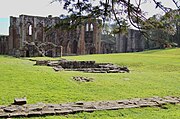  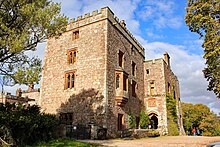
GalleryNotable people
See also
References
External linksWikimedia Commons has media related to Cumbria. Wikivoyage has a travel guide for Cumbria.
|
|||||||||||||||||||||||||||||||||||||||||||||||||||||||||||||||||||||||||||||||||||||||||||||||||||||||||||||||||||||||||||||||||||||||||||||||||||||||||||||||||||||||||||||||||||||||||||||||||||||||||||||||||||||||||||||||||||||||||||||||||||||||||||||||||||||||||||||||||||||||||||||||||||||||||||||||||||||||||||||||||||||||||||||||||||||||||||||||||||||||||||||||||||||||||||||||||||||||||||||||||||||||||||||||||||||||||||||||||||||||||||||||||||||||||||||||||||||||||||||||||||||||||||||||||||


